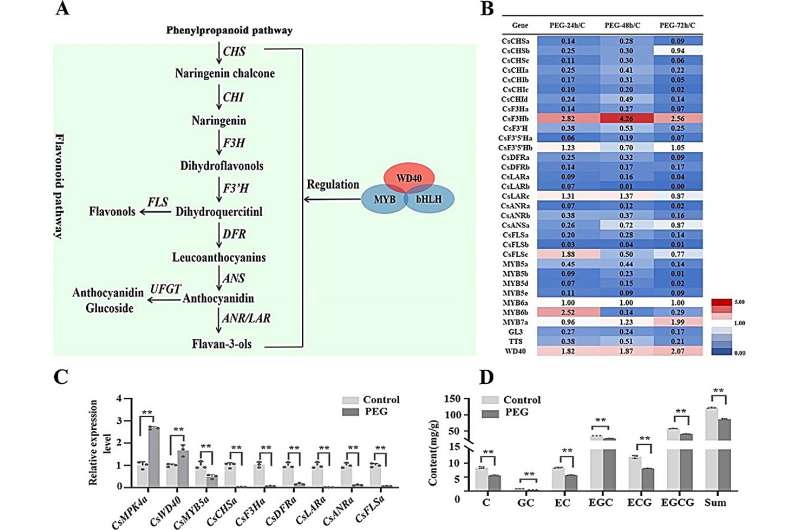This article has been reviewed according to Science X's editorial process and policies. Editors have highlighted the following attributes while ensuring the content's credibility:
fact-checked
peer-reviewed publication
proofread
The molecular shield: How tea plants combat drought through protein phosphorylation

Drought stress poses a significant challenge to agriculture, causing substantial yield losses in many crops. Tea plants, known for their rich flavonoid content which enhances both quality and health benefits, are particularly affected. Under drought conditions, the production of these valuable compounds declines, impacting the overall quality of tea.
Addressing these issues requires a deeper understanding of the molecular mechanisms that regulate flavonoid biosynthesis during drought stress. Due to these problems, it is essential to undertake detailed research to uncover strategies that can mitigate the negative effects of drought on tea plants.
Researchers from Anhui Agricultural University have published a study on May 5, 2024, in the journal Horticulture Research. The study investigates the phosphorylation of a WD40-repeat protein (CsWD40) and its role in regulating flavonoid biosynthesis in tea plants under drought stress. The findings provide new insights into the molecular responses of tea plants to environmental stress.
The study reveals that drought stress increases the expression of CsMPK4a, a mitogen-activated protein kinase, in tea leaves. CsMPK4a interacts with the WD40-repeat protein CsWD40, phosphorylating it at specific sites (Ser-216, Thr-221, and Ser-253). This phosphorylation disrupts CsWD40's interaction with key transcription factors responsible for flavonoid biosynthesis, leading to reduced flavonoid production.
Experiments introducing dephosphorylated (CsWD403A) and phosphorylated (CsWD403D) variants of CsWD40 into Arabidopsis plants further confirmed this regulatory mechanism. Dephosphorylated CsWD40 enhanced flavonoid production, while phosphorylated CsWD40 significantly decreased it.
Additionally, transient overexpression of these variants in tea leaves under stress conditions mirrored these results, indicating the phosphorylation state of CsWD40 plays a crucial role in modulating flavonoid biosynthesis. This detailed analysis provides new insights into how tea plants respond to drought at the molecular level, highlighting potential targets for improving stress tolerance.
Dr. Liping Gao, one of the corresponding authors, stated, "Our findings uncover a critical regulatory mechanism that affects flavonoid biosynthesis in tea plants under drought stress. Understanding this pathway opens up new possibilities for breeding drought-resistant tea varieties with optimized flavonoid content."
The discovery of the phosphorylation sites on CsWD40 provides potential targets for gene editing to develop tea cultivars with enhanced drought tolerance and stable flavonoid production. This research not only contributes to the fundamental understanding of stress responses in tea plants but also offers practical applications in improving tea quality and resilience to environmental stressors.
More information: Zhu Li et al, The phosphorylation of a WD40-repeat protein negatively regulates flavonoid biosynthesis in Camellia sinensis under drought stress, Horticulture Research (2024). DOI: 10.1093/hr/uhae136
Journal information: Horticulture Research
Provided by TranSpread




















